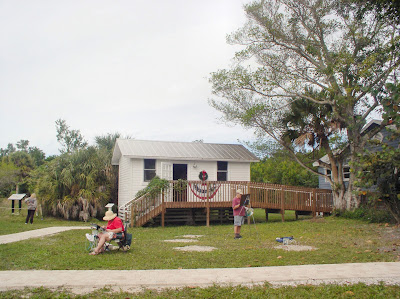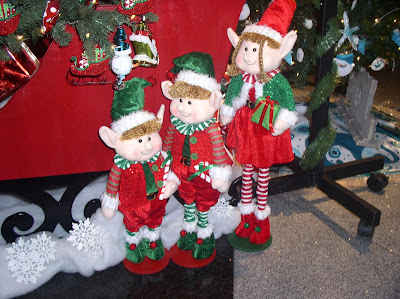Members of Bay Oaks Social Seniors went to Sanibel Island on December 10, 2015, to tour the Sanibel Historical Museum and Village. The group toured nine buildings which reflect life on Sanibel as it was from the 1880s through the 1940s. Sanibel was settled by farmers and fishermen, and the buildings of the village are either restorations or replicas of the originals. Among the buildings are a pioneer home from the early 1900s, a general store, a schoolhouse, a tearoom, 2 Sears Roebuck catalog kit homes, a post office rebuilt from hurricane debris, and a packing house. The buildings have a feeling of authenticity because they are furnished with items that belong to an earlier period in the history of Sanibel. After the tour, the group had lunch at Skip One Seafood Restaurant on the way home from Sanibel.
Map of the Historical Village
Sanibel Historical Museum and Village was founded in 1984 with a mission to preserve and share Sanibel history. The historic buildings were moved from their original island sites to the Historical Village. Each building has been restored to its original state. Sanibel residents donated many of the items that are found in the buildings.
Shore Haven
Shore Haven is one of the more recent additions to the village. It is a 1924 Sears Kit home that was a private residence for many years but now serves as the Welcome Center for the Historical Village. It was donated to the Sanibel Historical Museum and Village in 2012.
Pergola over walkway to Shore Haven.
The theme is “Celebrating Christmas, 1945” for soldiers returning from WWII. Sarah is with BOSS members Carmen, Leslie, Roger, Jean, Sharon, Ralph, April, Virginia and John.
Leslie is in the picture gallery at Shore Haven
The artwork is by artists who belong to the local art association.
Carmen & Jean in the Welcome Center of Shore Haven
The Rutland House - 1913
The Rutland House is a typical “cracker” style home. It has eleven-foot ceilings, cross ventilation, a hip roof, a wide porch and is on pilings to let air flow underneath--all features to maximize good air circulation. The "dog trot,” an open hallway from the front to the rear of the house, opening at both ends, also provides much-needed ventilation. The style provided shelter from the Florida sun and made the most of breezes. Today the simplistic style is newly appreciated for its energy efficiency and charm.
(FYI: The term “cracker” is derived from the sound Florida cattlemen made when cracking their whips. After the Civil War, raising cattle was, and still is, one of the biggest businesses in the state.)
Sharon & Ralph entering the Rutland House
Clarence Rutland came to the island with his parents in 1896 at the age of six and was a jack-of-all-trades. In the 1920s he earned seven cents per crate packing tomatoes and peppers for farmers. Rutland bought the house in 1928 for $2,000. He lived there until his death in 1982, when it was moved to the village and became the first building to house the Sanibel Historical Museum.
A Christmas tree and toys in the Rutland House
Settee draped with patriotic bunting in the Rutland House salon
The salon viewed from the dining room
A view from the salon through the dining room and into the kitchen
The dining room table
Fireless cook stove
If the soapstone radiators of the Toledo Fireless Cookstove were heated for 20 minutes, the stove conserved heat so well for so long that it could bake bread and cake and roast meat as well as a kitchen range.
High chair on wheels
Twin Bedroom with mosquito netting
The Calusa Indians room
Mock-up of Calusa Mounds
Victory Garden with Mike, a volunteer gardener.
The Old Sanibel School House for White Children - 1896
Burnap Cottage - 1898
Hiram Burnap purchased the cottage and used it as a fishing retreat in the winter. In 1998, the building was donated to the village and restored to its original state. Some say a ghost still haunts the building.
Burnap Cottage
The cottage houses a lens from the Sanibel lighthouse, and the captain’s wheel from the Algiers is in the background.
Inside Miss Charlotta’s Tea Room
Outside the Post Office - 1926
Packages and the postmaster inside the post office
Will Reed was postmaster until 1940
The Calusa Indians room
Dating as far back as 2,500 years, the native Calusa Indians were the first-known residents of the island. The Calusa used the waterways around the island for food and tools. Whelks, conchs, clams, oysters, and other seafood were used for food, and their empty shells were crafted into tools.
The Calusa were skilled builders and craftsmen, perching their huts high atop shell mounds to provide protection from storm tides. Some of their shell mounds, which were also used for ceremonial, ritual and burial sites, remain intact today.
Our group viewing the Victory Garden
(Victory Gardens were planted during the war to supplement the food supply.)
The Old Sanibel School House for White Children - 1896
The building has its original school bell. In the 1960s, after a new school house was built, the new school became the first integrated school in Lee County. After the school was vacated, the building became a theater. In December of 2004, the building was moved to the Historical Village and restored to its 1920 appearance.
The School House is a classic one-room schoolhouse with a wood stove used to warm the room in winter. In 1932, a second room was added, more windows installed, and the schoolhouse was able to house grades one through eight.
Hiram Burnap purchased the cottage and used it as a fishing retreat in the winter. In 1998, the building was donated to the village and restored to its original state. Some say a ghost still haunts the building.
Burnap Cottage
Inside the Burnap Cottage, there are artifacts from the Algiers, a ferry turned into a riverboat mansion, which had Italian terrazzo tiles, French marble countertops and sinks inlaid with gold seahorses, and gold-plated dolphin faucets spitting softened water into bathroom sinks. There was an elevator to take people to the top deck and a restaurant-equipped kitchen boasting a microwave. The Algiers was ill-fated and never used as a “pleasure palace” by its owners. (The farm boy in the foreground was not part of our group.)
The cottage houses a lens from the Sanibel lighthouse, and the captain’s wheel from the Algiers is in the background.
Miss Charlotta’s Tea Room - 1926
Outside the Post Office - 1926
The Sanibel Post Office was established on April 2, 1900. The front porch of Will Reed’s house on San Carlos Bay served as the post office. After the hurricane of 1926 washed away Reed’s house, there was enough debris found to build this small post office.
Will Reed was postmaster until 1940
Bailey’s General Store - 1927
Bailey’s General Store was the center of activity on the island with telephone and telegraph links, while steamer, ferry and mail boats stopped at the docks. Islanders voted here, sent and received mail and caught up on the latest news.
Ralph and Roger examine a gas pump in front of Bailey’s.
Inside Bailey’s General Store
Staples on the shelves of Bailey’s General Store
A replica of the ferry from the steam ship line in the store
Farm tools in the store.
Morning Glories Cottage - 1925
The bathroom in the cottage
Staples on the shelves of Bailey’s General Store
Agriculture was the main commerce for Sanibel settlers from the 1880s to the 1940s. Eventually tidal surges that washed over the island during several hurricanes rendered the soil useless for large-scale farming.
Caretakers’ Cottage
This cottage was built after 1925 behind Shore Haven. At one time or another, it served as a guest house, bath house, caretakers’ cottage and annex. It was donated and moved to the village with Shore Haven in 2012.
The cottage features an exhibit of Sanibel’s Black History.
This house, a Sears & Roebuck prefabrication, cost $2211 and was delivered to Sanibel in 1925. The building came to the island in 30,000 pieces on a flatbed truck aboard a barge. A few years ago, Morning Glories was donated to the Village, and a group of volunteers labored for almost a year to restore the building to its present condition. It is quite charming, and restoring it must have been a labor of love because everything about the cottage is so carefully and thoughtfully done. In addition, it seems eminently livable. It is a typical winter home on Sanibel in the 20s and 30s.
A child’s room in the cottage
The breakfast nook and kitchen in the Morning Glories cottage
The home had its own generator to provide electricity
The screened-in back porch of the Morning Glories cottage
The breakfast nook and kitchen in the Morning Glories cottage
The home had its own generator to provide electricity
BOSS members ready to have lunch at Skip One Seafood Restaurant



























































































